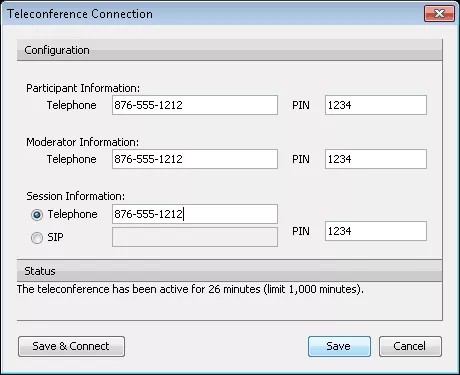The session creator can configure the teleconference connection information for third party providers. If not, you must provide the information before you can connect a session to a teleconference.
You can configure teleconference connection information only if telephony was enabled for the session by the session creator in the Blackboard Collaborate session scheduling server (ELM or the Session Administration System).
Use this information to connect to a teleconference that has already been set up. If you need a new teleconference, contact your teleconference administrator.
How to Configure Teleconference Connection Information
- Obtain the phone numbers, PINs, and SIP (Session Initiation Protocol, if required) from your teleconference administrator.
- From the Audio & Video options menu, click Configure Telephone Conference.
- In the Teleconference Connection window, type the connection information:
- Telephone number (North American only) and PIN for participants
- Telephone number (North American only) and PIN for moderators
- Telephone number (North American only) or SIP URI and PIN for the session-the teleconference bridge. A SIP URI should have the following format: sip:xxx@host.domain. The information you provide is processed by the teleconferencing bridge and sent over the connection to the telephone network.
The session is the bridge that connects the Blackboard Collaborate session to the teleconference. The bridge is listed as Teleconference in the participants list. If the teleconference bridge will be used to simulate the role of teleconference chairperson, type the teleconference chairperson's PIN in the PIN box.
- Save the teleconference information:
- Click Save & Connect to connect to the teleconference immediately.
- Click Save to connect later.
Telephone Number Formats
You must type telephone numbers in a North American format. The characters are limited to the numbers 0 to 9, spaces, hyphens, periods, and parentheses. International numbers outside of North America are not valid.
The following are examples of valid telephone number formats:
- 1-xxx-xxx-xxxx
- 1 xxx xxx xxxx
- 1 (xxx) xxx xxxx
- 1 (xxx) xxx-xxxx
- xxx-xxx-xxxx
- xxx xxx xxxx
- (xxx) xxx-xxxx
- xxx.xxx.xxxx
Programmed Responses
You can provide programmed responses in the Session PIN box. Many call centers provide interactive functions to their users with the telephone keypad. Typically, such commands include the # symbol followed by two or three digits. For example, #42 can mean "skip roll call" and #13 can mean "re-record my roll call entry." The codes vary with each provider. Contact your teleconference administrator for details.
You can also program pauses into your PIN to leave time for the completion of an automated greeting or to include a programmed response. To add a pause, type a comma.
The following examples are valid entries in the PIN box:
,,, 1212
#421212
,#42,1212
If the PIN is not accepted, call the number from a land line or cell phone. If you are asked to follow the PIN with a # key, then add that to the PIN box. You may also add more commas before the PIN to provide more time for an automated message to complete.
